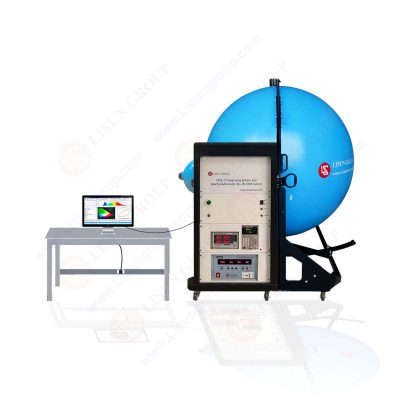Origin and development of integrating sphere:
The use of integrating sphere in measuring luminous flux can be traced back to 1890, and now it has become a widely used instrument in many aspects. The integrating sphere can be used to test the luminous flux, color temperature, light efficiency and other parameters of the light source. It is an indispensable instrument in the measurement of radiance, chromaticity and photometry.

Definition of integrating sphere:
The integrating sphere is a hollow sphere whose inner wall is coated with white diffuse reflection material, also known as a photometric sphere, a luminous flux sphere, etc. The spherical wall is provided with one or several windows, which are used as light inlet holes and receiving holes for placing light receiving devices. The inner wall of the integrating sphere shall be a good spherical surface, and the deviation from the ideal spherical surface shall not be greater than 0.2% of the inner diameter. The inner wall of the ball is coated with an ideal diffuse reflection material, that is, a material with a diffuse reflection coefficient close to 1, so that the spectral reflectance of the visible light of the inner wall of the ball is above 99%.
Function of integrating sphere:
1. Optical receiver
The measured light enters the sphere through the small hole on the integrating sphere, and one or two photodetectors are set on the inner wall. The photocurrent output by the photodetectors is proportional to the illuminance of the inner wall of the integrating sphere. In this way, the change of the luminous flux entering the integrating sphere can be known according to the change of the output photocurrent.
2. Uniformly illuminated object surface
Several bulbs (usually four or six) are uniformly arranged symmetrically with the light exit holes on the inner wall of the integrating sphere. The light emitted by the bulb is diffusely reflected by the inner wall for many times to form a uniform and bright luminous sphere, which is used to measure the vignetting coefficient of the photographic objective lens and the illumination uniformity of the image plane.
3. Spherical collimator
The integrating sphere with collimating objective lens, bulb and black and white stoppers is called spherical collimator, which is used to measure the stray light coefficient of the telescope coefficient. During integrating sphere measurement, the illuminance of the black body target image and the “white stopper” image is measured by the photodetector, that is, the corresponding indication value measured by the photodetector respectively, and the stray light coefficient of the measured telescope can be obtained through calculation. Because, if the image of a blackbody target in the bright sky is not completely black, it means that in addition to imaging the target, the telescope also has stray light on the image plane.
Advantages of using an integrating sphere light measurement device:
1. In general, the optical diffusion sheet can reduce the slight error caused by the uneven distribution of the incident light source on the detector or the slight deviation of the light beam when it is used carefully, thus improving the accuracy of measurement; However, in more precise measurement, you must use the integrating sphere as the optical diffuser to minimize the above error.
2. When the integrating sphere is used to measure the luminous flux (lumen), the measurement result can be more reliable; The integrating sphere can reduce and eliminate the measurement errors caused by the shape of the light, the divergence angle, and the difference in the responsiveness of different positions on the detector.
3. The integrating sphere can also be matched with the spectrometer, and the light output hole of the integrating sphere is connected in front of the incident grating of the spectrometer to ensure that the angle of the light source to be measured into the spectrometer is the same; So that the reproducibility of the measurement is greatly improved.
LISUN lauchedLPCE-2 Integrating Sphere Spectroradiometer LED Testing System is for single LEDs and LED lighting products light measurement. LED’s quality should be tested by checking its photometric, colorimetric and electrical parameters. According to CIE 177, CIE84, CIE-13.3, IES LM-79-19, Optical-Engineering-49-3-033602, COMMISSION DELEGATED REGULATION (EU) 2019/2015, IESNA LM-63-2, IES-LM-80 and ANSI-C78.377, it recommends to using an array spectroradiometer with an integrating sphere to test SSL products. The LPCE-2 system is applied with LMS-9000C High Precision CCD Spectroradiometer or LMS-9500C Scientific Grade CCD Spectroradiometer, and A molding integrating sphere with holder base. This sphere is more round and the test result is more accruacy than the traditional integrating sphere.
LPCE-3 is a CCD Spectroradiometer Integrating Sphere Compact System for LED Testing. It is suitable for single LED and LED luminaires’ photometric, colorimetric and electrical measurement. The measured data meets the requirements of CIE 177, CIE84, CIE-13.3, COMMISSION DELEGATED REGULATION (EU) 2019/2015, IES LM-79-19, Optical-Engineering-49-3-033602, IESNA LM-63-2, ANSI-C78.377 and GB standards

CCD Spectroradiometer Integrating Sphere Compact System LPCE-3
Lisun Instruments Limited was found by LISUN GROUP in 2003. LISUN quality system has been strictly certified by ISO9001:2015. As a CIE Membership, LISUN products are designed based on CIE, IEC and other international or national standards. All products passed CE certificate and authenticated by the third party lab.
Our main products are Goniophotometer, Integrating Sphere, Spectroradiometer, Surge Generator, ESD Simulator Guns, EMI Receiver, EMC Test Equipment, Electrical Safety Tester, Environmental Chamber, Temperature Chamber, Climate Chamber, Thermal Chamber, Salt Spray Test, Dust Test Chamber, Waterproof Test, RoHS Test (EDXRF), Glow Wire Test and Needle Flame Test.
Please feel free to contact us if you need any support.
Tech Dep: Service@Lisungroup.com, Cell/WhatsApp:+8615317907381
Sales Dep: Sales@Lisungroup.com, Cell/WhatsApp:+8618117273997
Your email address will not be published. Required fields are marked *